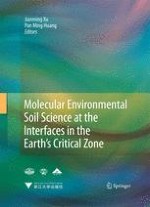2010 | OriginalPaper | Buchkapitel
Dynamic Behavior of Persistent Organic Pollutants in Soil and Their Interaction with Organic Matter
verfasst von : Malik Tahir Hayat, Jianming Xu, Na Ding, Tariq Mahmood
Erschienen in: Molecular Environmental Soil Science at the Interfaces in the Earth’s Critical Zone
Verlag: Springer Berlin Heidelberg
Aktivieren Sie unsere intelligente Suche, um passende Fachinhalte oder Patente zu finden.
Wählen Sie Textabschnitte aus um mit Künstlicher Intelligenz passenden Patente zu finden. powered by
Markieren Sie Textabschnitte, um KI-gestützt weitere passende Inhalte zu finden. powered by
Persistent organic pollutants (POPs) pose threat to environment because of their potential for longrange atmospheric transport, bioaccumulation and toxicity. The POPs behave dynamically in the environment according to their nature of action like volatilization, sorption, desorptin and transportation from their source of production to some where. These POPs migrate on air currents from warmer regions of the globe towards the colder Polar Regions. Once they reach colder temperatures they condense, precipitate out, and are deposited again on the earth’s surface. Environmental variables like temperature, soil pH, moisture have serious effects on the POPs behavior in the soil. Inorganic minerals also have good interaction with the xenobiotics and play an important role in the transformation of xenobiotics. The manganese and iron oxides and clay minerals (e.g. smectites containing Fe(III)) have well-documented properties to promote the oxidation of a number of organic pollutants. Organic matter is considered the most important factor limiting availability and mobility of POPs in soil and a substantial percentage of the total amount of an organic contaminant applied to a soil may become associated with the humic fraction of that soil. Organic pollutants strongly adsorb to carbonaceous sorbents such as black carbon. In particular, activated charcoal (AC) is known for a strong adsorptive capacity due to its high specific surface area. Adsorption to activated charcoal can render hazardous organic pollutants in soils and sediments less available to organisms and hinder their dispersal into unaffected environments. Some studies also show that some sorbents from natural organic materials, such as peat, soybean stalk and pine needle under superheated temperature/ pressure conditions, for sorption of polycyclic aromatic hydrocarbons (PAHs) in contaminated soils. Natural materials significantly decrease the extractability and bioavailability of PAHs from contaminated soils. Main objective of this review article is to compile some valuable information regarding the existence, dynamic behavior, effect of environmental variables on POPs and their interactions with organic matter.
